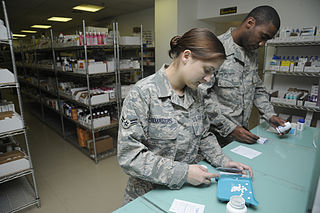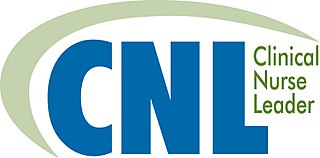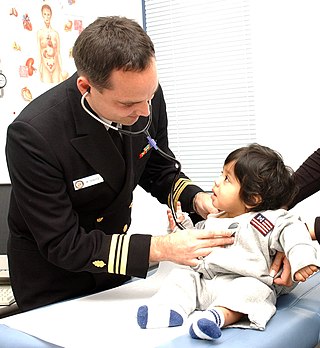
Phlebotomy is the process of making a puncture in a vein, usually in the arm, with a cannula for the purpose of drawing blood. The procedure itself is known as a venipuncture, which is also used for intravenous therapy. A person who performs a phlebotomy is called a phlebotomist, although most doctors, nurses, and other technicians can also carry out a phlebotomy. In contrast, phlebectomy is the removal of a vein.

A pharmacy technician performs pharmacy-related functions. Training, certification, licensing, and actual practice of pharmacy technicians varies not only worldwide but in some countries regionally as well as by employer.

A surgical technologist, also called a scrub, scrub tech, surgical technician, or operating department practitioner or operating room technician, is an allied health professional working as a part of the team delivering surgical care. Surgical technologists are members of the surgical team. The members of the team include the surgeon, surgeon's assistant, circulator nurse and anesthesia provider. They possess knowledge and skills in sterile and aseptic techniques. There are few mandatory professional requirements for surgical technologists, and the scope of practice varies widely across countries and jurisdictions. Surgical technologists attend junior colleges and technical schools, and many are trained in military schools. In the military they perform the duties of both the circulator and the scrub. The goal is for surgical technologists to be able to anticipate the next move the surgeon is going to make in order to make the procedure as smooth and efficient as possible. They do this by having knowledge of hundreds of surgical procedures and the steps the surgeon needs to take in order to complete the procedure, including the very wide range of surgical instruments they may need. Specialties can include, but are not limited to, the following: genitourinary, obstetrics and gynaecology, urology, ENT, plastics, general, orthopedics, neurology, and cardiovascular. They only work in surgical or perioperative areas and are highly specialized. Surgical technologist is the proper term for a two-year program which earns a degree in applied sciences. The profession is up and coming and highly in demand.
A medical assistant, also known as a "clinical assistant" or healthcare assistant in the US is an allied health professional who supports the work of physicians, nurse practitioners, physician assistants and other health professionals, usually in a clinic setting. Medical assistants can become certified through an accredited program. Medical assistants perform routine tasks and procedures in a medical clinic.
Allied health professions are health care professions that provide a range of diagnostic, technical, therapeutic, and support services in connection with health care. Their services are allied with and support the work of a number of other professions not considered allied health professions, such as medicine, nursing, dentistry, optometry, pharmacy, and others listed below as "excluded professions".

A medical laboratory scientist (MLS) or clinical laboratory scientist (CLS) or medical technologist (MT) performs diagnostic testing of blood and body fluids in clinical laboratories. The scope of a medical laboratory scientist's work begins with the receipt of patient or client specimens and terminates with the delivery of test results to physicians and other healthcare providers. The utility of clinical diagnostic testing relies squarely on the validity of test methodology. To this end, much of the work done by medical laboratory scientists involves ensuring specimen quality, interpreting test results, data-logging, testing control products, performing calibration, maintenance, validation, and troubleshooting of instrumentation as well as performing statistical analyses to verify the accuracy and repeatability of testing. Medical laboratory scientists may also assist healthcare providers with test selection and specimen collection and are responsible for prompt verbal delivery of critical lab results. Medical Laboratory Scientists in healthcare settings also play an important role in clinical diagnosis. An estimated 70% of medical decisions are based on laboratory test results and MLS contributions affect 95% of a health system's costs.
Health information management (HIM) is information management applied to health and health care. It is the practice of analyzing and protecting digital and traditional medical information vital to providing quality patient care. With the widespread computerization of health records, traditional (paper-based) records are being replaced with electronic health records (EHRs). The tools of health informatics and health information technology are continually improving to bring greater efficiency to information management in the health care sector.

Clinical Nurse Leader (CNL) is a relatively new nursing role that was developed in the United States to prepare highly skilled nurses focused on the improvement of quality and safety outcomes for patients or patient populations. The CNL is a registered nurse, with a Master of Science in Nursing who has completed advanced nursing coursework, including classes in pathophysiology, clinical assessment, finance management, epidemiology, healthcare systems leadership, clinical informatics, and pharmacology. CNLs are healthcare systems specialists that oversee patient care coordination, assess health risks, develop quality improvement strategies, facilitate team communication, and implement evidence-based solutions at the unit (microsystem) level. CNLs often work with clinical nurse specialists to help plan and coordinate complex patient care.

A family nurse practitioner (FNP) provides continuing and comprehensive healthcare for the individual and family across all ages, genders, diseases, and body systems. Primary care emphasizes the holistic nature of health and it is based on knowledge of the patient in the context of the family and the community, emphasizing disease prevention and health promotion.

Nurses in Canada practise in a wide variety of settings, with various levels of training and experience. They provide evidence-based care and educate their patients about health and disease.
Hawaiʻi Technology Institute was a non-profit, vocational school located in Honolulu, Hawaii. It has been licensed by the State of Hawaii Department of Education as a private trade, vocational, and technical school.

The American Society of Anesthesia Technologists & Technicians, or ASATT, based in Oak Creek, Wisconsin, is a non-profit, educational organization responsible for the standards of technologist/technician competency in all areas of anesthesia.
Unlicensed assistive personnel (UAP) are paraprofessionals who assist individuals with physical disabilities, mental impairments, and other health care needs with their activities of daily living (ADLs). UAPs also provide bedside care—including basic nursing procedures—all under the supervision of a registered nurse, licensed practical nurse or other health care professional. UAPs must demonstrate their ability and competence before gaining any expanded responsibilities in a clinical setting. While providing this care, UAPs offer compassion and patience and are part of the patient's healthcare support system. Communication between UAPs and registered nurses (RNs) is key as they are working together in their patients' best interests. The scope of care UAPs are responsible for is delegated by RNs or other clinical licensed professionals.
Arizona Medical Training Institute (AMTI) is a private, vocational healthcare institute located in Mesa, Arizona. They provide entry-level medical training for students seeking careers in nursing, clinical laboratory science and the assisted living career fields.
A healthcare technician is a health professional that provides care to patients. Healthcare technician's primary position is to assist medical staff complete tasks around their assigned unit or clinic's and accommodate patient needs. Healthcare technicians are typically found in specialty clinics, intensive care, emergency departments, or laboratory collection facilities. Technicians will perform basic cardiology reports such as, electrocardiograms and will have basic understanding of bodily function. The technician is an integral member of the unit-based healthcare team, they contribute to the continuity of care by decreasing fragmentation through decentralization of selected diagnostic and therapeutic treatment modalities.

The Society for Simulation in Healthcare (SSH), formerly known as the Society for Medical Simulation is a non-profit organization founded in 2004 to advance the application of medical simulation in healthcare. It serves as a resource for young professionals in their growth in medical education and administration.
Ultimate Medical Academy (UMA) is a nonprofit career education school that grants associate degrees and training in the allied health field. The institution also provides continuing medical education (CME) to more than 30,000 physicians, nurses and other medical professionals annually.
Gurnick Academy is a private for-profit higher-education institution in California providing nursing, imaging and allied health programs. The school’s corporate office is located in San Mateo, California, and it operates six campuses, in San Mateo, Concord, Modesto, Fresno, Sacramento and Los Angeles as well as offering distance education online. The academy is operated and owned by the Gurnick Academy of Medical Arts, with Konstantin Gourji serving as the chief executive officer.








